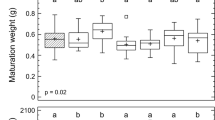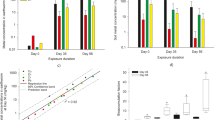Abstract
Accumulation of Zn and its effects on the growth, reproduction and life cycle of the earthworm Drawida willsi were determined. D. willsi did not reveal any significant changes in their mass at any of the concentrations of Zn (50, 200 and 400 mg kg–1) compared to in untreated soils. The Zn concentrations in the exposed earthworms were significantly increased, but they were able to regulate their body content of Zn within a range of 116–125 mg kg–1 (dry wt) in 200–400 mg kg–1 Zn-treated soil. Reproduction was significantly reduced when the Zn concentration in soil exceeded 200 mg kg–1. The drop in reproduction at elevated concentrations of Zn apparently resulted in a delay in completion of the life cycle and a decline in the total population.
Similar content being viewed by others
Author information
Authors and Affiliations
Additional information
Received: 9 September 1998
Rights and permissions
About this article
Cite this article
Panda, R., Pati, S. & Sahu, S. Accumulation of zinc and its effects on the growth, reproduction and life cycle of Drawida willsi (Oligochaeta), a dominant earthworm in Indian crop fields. Biol Fertil Soils 29, 419–423 (1999). https://doi.org/10.1007/s003740050574
Issue Date:
DOI: https://doi.org/10.1007/s003740050574




